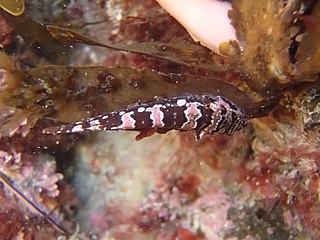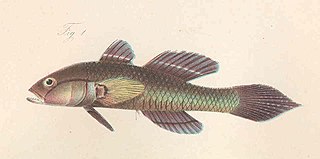
The large kelpfish, the Eastern kelpfish, hiwihiwi, surgefish or kelpfish, is a species of marine ray-finned fish, a kelpfish belonging to the family Chironemidae. It is found in southern Australia, and off the North Island of New Zealand, at depths down to 30 m.

Hector's clingfish is a clingfish of the family Gobiesocidae, the only species in the genus Gastrocyathus. It is found all down the east coast of New Zealand around the low water mark amongst seaweed, on rocky coastlines. Its length is up to 6.4 centimetres (2.5 in) SL. This species was described in 1876 by Albert Günther as Crepidogaster hectoris from a holotype collected on the south shore of the Cook Strait. Günther honoured the Scottish-born scientist James Hector (1834-1907) who was the Director of the Geological Survey of New Zealand and who presented type to the British Museum.

The bluering angelfish, also known as the annularis angelfish and the blue king angelfish, is a species of marine ray-finned fish, a marine angelfish belonging to the family Pomacanthidae. It is member of the genus Pomacanthus, composed of large marine angelfish.
Entomacrodus cadenati is a species of fish in the family Blenniidae.
The Waigeo rainbowfish is a species of rainbowfish in the subfamily Melanotaeniinae. It is endemic to West Papua in Indonesia. It reaches a maximum length of around 7.5 cm. This species was described as Rhombatractus catherinae in 1910 by Lieven Ferdinand de Beaufort from a type locality which was given as a rivulet flowing into the Rabial River in Waigeo. de Beaufort gave this species the specific name catherinae to honour his wife, Catherine, who had assisted him on the expedition on which the type was collected.

The redbreast tilapia is a species of fish in the family Cichlidae. It is found widely in the southern half of Africa. Its natural habitats are freshwater lakes and freshwater marshes. It is known as the redbreast kurper in South Africa.

Pomacanthus semicirculatus, also known as the semicircled angelfish, Koran angelfish, blue angelfish, zebra angelfish or half-circled angelfish, is a species of ray-finned fish, a marine angelfish, in the family Pomacanthidae. It is found in the Indo-West Pacific Ocean. It occasionally makes its way into the aquarium trade.
Doumea chappuisi is a species of loach catfish found in the coastal rivers of Guinea, Ivory Coast, Liberia and Guinea-Bissau. It reaches a length of 11.4 cm.
Gerald Robert "Gerry" Allen is an American-born Australian ichthyologist. His career began in 1963, when he spent a semester at the University of Hawaii, where he also received a PhD in marine zoology in 1971. In 1972, Allen wrote his doctoral thesis on the systematics and biology of the anemone fish.

Porogobius schlegelii is a species of goby native to brackish and fresh waters along the Atlantic coast of Africa from Senegal to the Democratic Republic of the Congo. It is also found in the islands of the Gulf of Guinea and Cape Verde. It occurs in inshore waters in lagoons, estuaries, the lower reaches of rivers and mangrove swamps. This species grows to a length of 14.9 centimetres (5.9 in) TL. This species is the only known member of its genus. The specific name honours the ichthyologist Hermann Schlegel (1804-1884) who supplied Günther with the type specimen from the Natural History Museum in Leiden.

The Chinamanfish, Chinaman snapper, galloper or thread-finned sea perch, is species of marine ray-finned fish, a snapper belonging to the family Lutjanidae. It is found in the Western Pacific Ocean.

The nightfish is a species of freshwater ray-finned fish, a temperate perch from the family Percichthyidae which is endemic to southwestern Australia.
Membras martinica, the rough silverside, is a species of Neotropical silverside from the family Atherinopsidae, it is the type species of the genus Membras.

The spotbanded scat,(Selenotoca multifasciata), also known as the striped scat, banded scat, barred scat, butterfish, John Dory, Johnny Dory, old maid, Southern butter-fish or striped butterfish, is a species of ray-finned fish, belonging to the family Scatophagidae, the scats. They are found in the eastern Indian Ocean and southwestern Pacific Ocean.
The bugeye dottyback, also known as Knight's dottyback, is a species of ray-finned fish, the only species in the monospecific genus Amsichthys, belonging to the subfamily Pseudoplesiopinae, of the family Pseudochromidae. It is found in the Indo-Pacific region.
The pinkeye mullet, also known simply as pinkeye, or freshwater mullet, Richmond mullet, or river mullet, is a species of ray-finned fish from the grey mullet family Mugilidae and the only species in the genus Trachystoma. It is endemic to northeastern Australia where it occurs from the Burnett River in Queensland to the Clyde River in New South Wales. It is a subtropical species which is found in deep, slow flowing sections of rivers as well as in estuaries although it moves into coastal seas to spawn. It feeds mainly on algae and plant material, as well as detritus and benthic invertebrates.

Scomberoides commersonnianus, the Talang queenfish, also known as giant dart, giant leatherskin, giant queenfish, largemouth queenfish, leatherjacket, leatherskin, and Talang leatherskin, is a species of ray-finned fish in the family Carangidae from the western Indo-Pacific. It is a large species which is important in commercial and recreational fisheries.
Arrhamphus krefftii, the snub-nosed garfish, is a species of halfbeak in the genus Arrhamphus found in coastal waters of Australia from south of Rockhampton in Queensland to Sydney. The identity of the person honoured in the specific name is uncertain but it is thought that it may be the Australian zoologist and paleontologist Gerard Krefft (1830–1881). This species was previously classified as a subspecies of Arrhamphus sclerolepis, and remains so according to some authorities. This species is a herbivore and eats seagrass during the day. At night, it is a carnivore, eating mainly crustaceans.

Pinjalo pinjalo, the pinjalo, is a species of marine ray-finned fish, a snapper belonging to the family Lutjanidae. It is found in the Indian and Western Pacific Oceans.

Scatophagus tetracanthus, the scatty or African scat is a species of ray-finned fish belonging to the family Scatophagidae, the scats. It is found in eastern Africa and Madagascar and in New Guinea and northern Australia.











